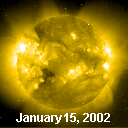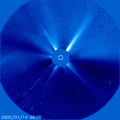|   SPACE WEATHER SPACE WEATHER
Current
Conditions
Solar Wind
velocity: 388.2 km/s
density:3.7 protons/cm3
explanation | more data
Updated: Today at 2245 UT
X-ray Solar Flares
6-hr max: C4 1730 UT Jan15
24-hr: C9 2250 UT Jan14
explanation | more data
Updated: Today at 2245 UT
Daily Sun: 15 Jan '02 
Active regions 9773 and 9782 have delta-class magnetic fields that harbor energy for X-class solar flares. Sunspots 9775 and 9785 have beta-gamma magnetic fields that could unleash M-class flares. Image credit: SOHO/MDI
The Far Side of the Sun

This holographic image reveals a substantial active region on the far side of the Sun. Image credit: SOHO/MDI
Sunspot Number: 174
More about sunspots
Updated: 12 Jan 2002
Radio Meteor Rate
24 hr max: 18 per hr
Listen to the Meteor Radar!
Updated: 15 Jan 2002 Interplanetary Mag. Field
Btotal: 5.6 nT
Bz: 0.8 nT north
explanation | more data
Updated: Today at 0027 UT Coronal Holes:

There are no substantial coronal holes on the Earth-facing side of the Sun. Image credit: SOHO Extreme UV Telescope.
More about coronal holes
 SPACE WEATHER SPACE WEATHER
NOAA
Forecasts
Solar Flares: Probabilities for a medium-sized (M-class) or a major (X-class) solar flare during the next 24/48 hours are tabulated below.
Updated at 2002 Jan 14 2210 UT
| FLARE | 0-24 hr | 24-48 hr | | CLASS M | 75 % | 75 % | | CLASS X | 20 % | 20 % |
Geomagnetic Storms: Probabilities for significant disturbances in Earth's magnetic field are given for three activity levels: active, minor storm, severe storm
Updated at 2002 Jan 14 2210 UT Mid-latitudes | 0-24 hr | 24-48 hr | | ACTIVE | 15 % | 15 % | | MINOR | 10 % | 10 % | | SEVERE | 01 % | 01 % |
High latitudes | 0-24 hr | 24-48 hr | | ACTIVE | 20 % | 15 % | | MINOR | 10 % | 10 % | | SEVERE | 01 % | 01 % |

Web server provided by
VPS Hosting | What's Up in Space -- 15 Jan 2002
Subscribe to Space Weather News! ASTEROIDS: Two asteroids will tumble past the Earth-Moon system on Jan. 16th: 1991 VK and 2002 AO11. Neither pose a threat to our planet. 1991 VK is about 2-km wide and will lie 28 lunar distances from Earth at closest approach; 2002 AO11 is a small asteroid -- about the size of a football field -- that will glide by our planet 12 times farther away than the Moon.  FIGURE-EIGHT: An M4-class eruption on the Sun Monday hurled a bright coronal mass ejection (CME) into space. Hot gas and twisted magnetic fields within the expanding cloud formed an eye-catching "figure-8" shape in SOHO coronagraph images (right). The source of the eruption was located behind the Sun's southeast limb; as a result this CME should not strike Earth's magnetosphere. FIGURE-EIGHT: An M4-class eruption on the Sun Monday hurled a bright coronal mass ejection (CME) into space. Hot gas and twisted magnetic fields within the expanding cloud formed an eye-catching "figure-8" shape in SOHO coronagraph images (right). The source of the eruption was located behind the Sun's southeast limb; as a result this CME should not strike Earth's magnetosphere.
SUNSPOTS: An impressive array of sunspots is rotating across the face of our star. Active regions 9773 and 9782 have twisted "delta-class" magnetic fields that harbor energy for X-class explosions.  NORTHERN LIGHTS: Solar wind gusts flowing from a coronal hole buffeted Earth's magnetosphere on Jan. 11th, igniting auroras over Canada, Alaska, and the northern tier of US states. Click for images. NORTHERN LIGHTS: Solar wind gusts flowing from a coronal hole buffeted Earth's magnetosphere on Jan. 11th, igniting auroras over Canada, Alaska, and the northern tier of US states. Click for images.
COMET ENCOUNTER: Last week periodic comet 96P/Machholz put on a dazzling show as it swung by the Sun. Click here for movies and more information. WEB LINKS: NOAA FORECAST | GLOSSARY | SPACE WEATHER TUTORIAL | LESSON PLANS | BECOME A SUBSCRIBER | 
Potentially Hazardous Asteroids (PHAs) are space rocks larger than approximately 100m that can come closer to Earth than 0.05 AU. None of the known PHAs are on a collision course with our planet, although astronomers are finding new ones all the time.
On 15 Jan 2002 there were 371 known Potentially
Hazardous Asteroids Jan. 2002 Earth-asteroid encountersNotes: LD is a "Lunar Distance." 1 LD = 384,401 km, the distance between Earth and the Moon. 1 LD also equals 0.00256 AU. MAG is the visual magnitude of the asteroid on the date of closest approach. 
- ASTEROID FLYBY: Asteroid 2001 YB5 raced past Earth on Jan. 7, 2002, only two times farther away than the Moon. [gallery]
- SUBTLE ECLIPSE: The Moon dipped into the outskirts of Earth's shadow on Dec. 30, 2001. [gallery]
- MOON & SATURN: The Moon keeps getting in the way of Saturn! See the series of close encounters here.
- CHRISTMAS LIGHTS: On Christmas Eve, 2001, a solar wind stream triggered Northern Lights. [gallery]
- SOLAR ECLIPSE: Sky watchers in Hawaii and most parts of North America experienced a partial solar eclipse on Dec. 14th. [gallery]
- BRIGHT ASTEROID: Videos and images of 1998 WT24 -- a big and bright near-Earth asteroid that came close to our planet on Dec. 16, 2001. [gallery]
- NORTHERN LIGHTS: On Nov. 24th a pair of coronal mass ejections swept past Earth and triggered worldwide auroras.
- LEONIDS 2001: Some people saw it. Others heard it. In either case, they'll never forget it: The 2001 Leonid meteor storm.
- PERSEIDS 2001: Perseid watchers on August 12th spotted meteors, auroras, and a disintegrating Russian rocket! [gallery]
- MORNING PLANETS: In July and Aug. 2001, the Moon, Jupiter, Saturn, Venus, and Mercury put on a dazzling early-morning sky show. [gallery]
- ECLIPSE SAFARI: Onlookers cried out in delight on June 21, 2001, when the Moon covered the African Sun, revealing the dazzling corona. [gallery]
- TOTAL LUNAR ECLIPSE: On Jan. 9, 2001, the full Moon glided through Earth's copper-colored shadow. [gallery]
- CHRISTMAS ECLIPSE: Sky watchers across North America enjoyed a partial solar eclipse on Christmas Day 2000 [gallery]
- LEONIDS 2000: Observers around the globe enjoyed three predicted episodes of shooting stars. [gallery]
 Nov. 7 , 2001: What Lies beneath a Sunspot -- Awesome plasma hurricanes were one of the surprises revealed when scientists peered beneath the stormy surface of our star. Oct. 26 , 2001: 'tis the Season for Auroras -- Autumn is a good time to spot Northern Lights. Oct. 17, 2001: Halley's Comet Returns ... in bits and pieces -- The annual Orionid meteor shower peaks on October 21st. Aug. 9, 2001: Horse Flies and Meteors -- Like bugs streaking down the side window of a moving car, long and colorful Perseid Earthgrazers could put on a remarkable show on August 11th. July 27, 2001: Meteorites Don't Pop Corn -- A fireball that dazzled Americans on July 23rd probably didn't scorch any cornfields, contrary to widespread reports. June 12, 2001: The Biggest Explosions in the Solar System -- NASA's HESSI spacecraft aims to unravel an explosive mystery: the origin of solar flares. |

